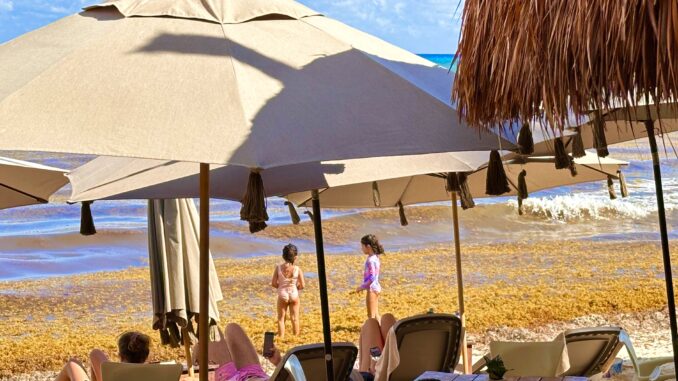
Seaweed in the Riviera Maya and Playa Del Carmen
We first wrote about the problem with seaweed back in 2014. That was the first noticeable year that the sargassum started wash up on our shores. Ever since, it has been up and down, with some years practically nonexistent and other years that discouraged tourism from arriving. In this article we are going to talk about the current forecast for this year, where you can get local information on how the beaches are, and even things to do to avoid the seaweed and still have a great vacation. We even have a good map of the Playa Del Carmen beaches so you can plan your stay better.
Note: Seaweed or sargassum? Are these terms the same? Not exactly — sargassum is a type of seaweed, but not all seaweed is sargassum. But, since most people use them interchangeably, and people search these two terms for answers, we use them both in this article.
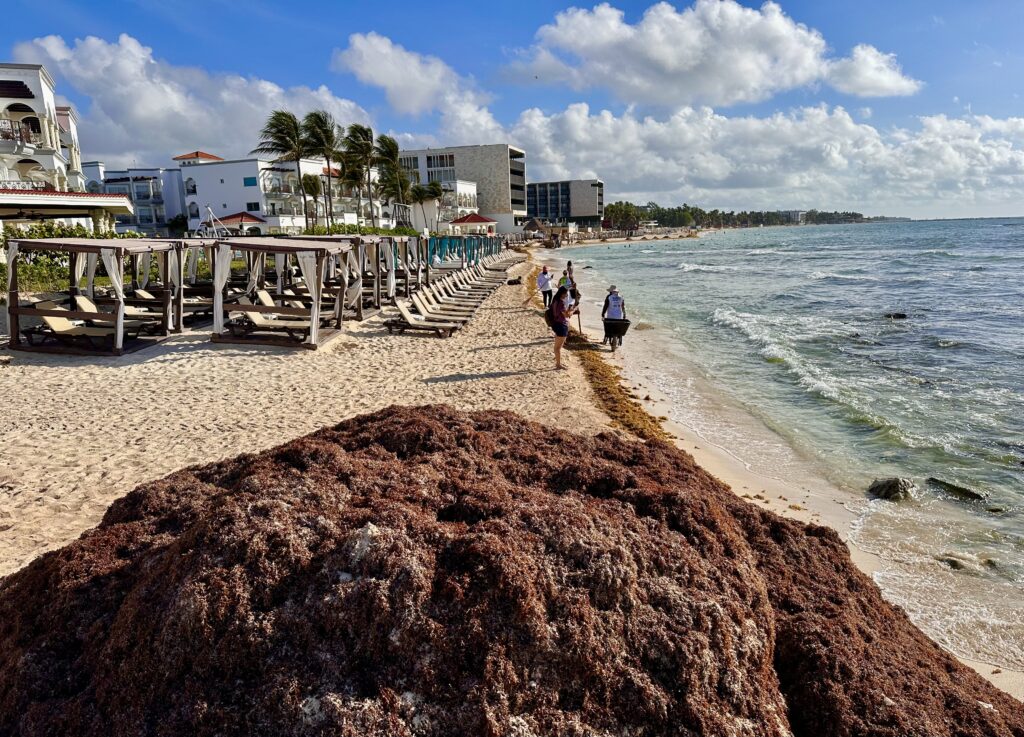
What is the current prediction for sargassum?
Well, the news does not look good for 2025. We might be in for a record-breaking year. Below is one of the best seaweed forecasting websites that has a lot of data to go through and also easy maps to look at.
The Sargassum Watch System (SaWS)
The University of South Florida Set up the Optical Oceanography Laboratory. The Sargassum Watch System (SaWS) is designed to use satellite data and numerical models to detect and track pelagic sargassum in near-real time. The raw satellite data are provided by the U.S. NASA and USGS. All of the data is combined into usable information to track sargassum over the Atlantic and Carribean areas. The information can give you a larger picture of the entire area and what amount of seaweed is coming toward landmasses. There are tons of information that you can dive into on their website.
The latest prediction from the Sargassum Watch Center
The map below shows average Sargassum abundance for the month of April 2025, with warm colors representing higher abundance. As predicted last month, the Sargassum amount in each region but the east Atlantic increased in April. The increases in the Gulf of Mexico and western Caribbean Sea were typical as in most previous years, but total amounts in the eastern Caribbean Sea and west Atlantic reached surprisingly high levels – they were both 200% higher than their historical records in April. Similarly, the total amount in all regions combined was 150% higher than the historical record in April. Furthermore, this total amount was 40% higher than the all-time high in June 2022, which makes 2025 a new record year. Most of these increases are due to both local growth and physical transport, but the exact reasons behind these new historical records need to be investigated. Corresponding to these increases, Sargassum beaching events have been reported around the Caribbean and along the southeast coast of Florida.
Looking ahead: As in most previous years, May is expected to see continued increases in most regions. More Sargassum is expected to be transported to the west Caribbean Sea and then to the Gulf through the Yucatan Straight. Sargassum inundation will continue to occur in most of the Caribbean nations and islands as well as along the southeast coast of Florida.
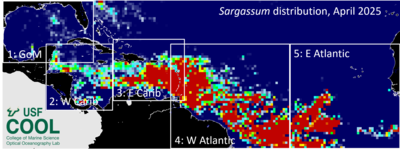
Here are two pictures taken in early May of 2025 in the center of Playa Del Carmen when a large amount of seaweed arrived.

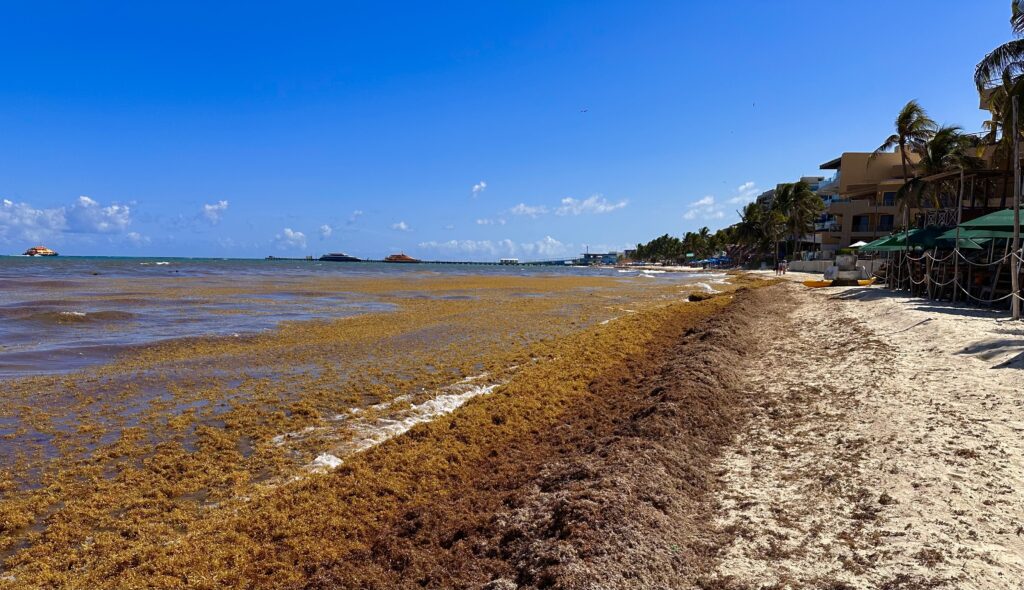
Where can you check for local seaweed forecast?
Here are two really informative places you can get local updates or regional photos as well as other parts of the Caribbean.
Facebook Page for monitoring sargassum
This Facebook page is an NGO run sargassum page with daily updates for the Cancun and Riviera Maya. It is called Red de Monitoreo del Sargazo de Quintana Roo. We often post the maps that they produce because they are very helpful in showing current conditions on the coast of Quintana Roo State where the Riviera Maya is. The five color traffic light system shows different beaches and categorizes them as without seaweed, low amounts, moderate, abundant, or excessive.
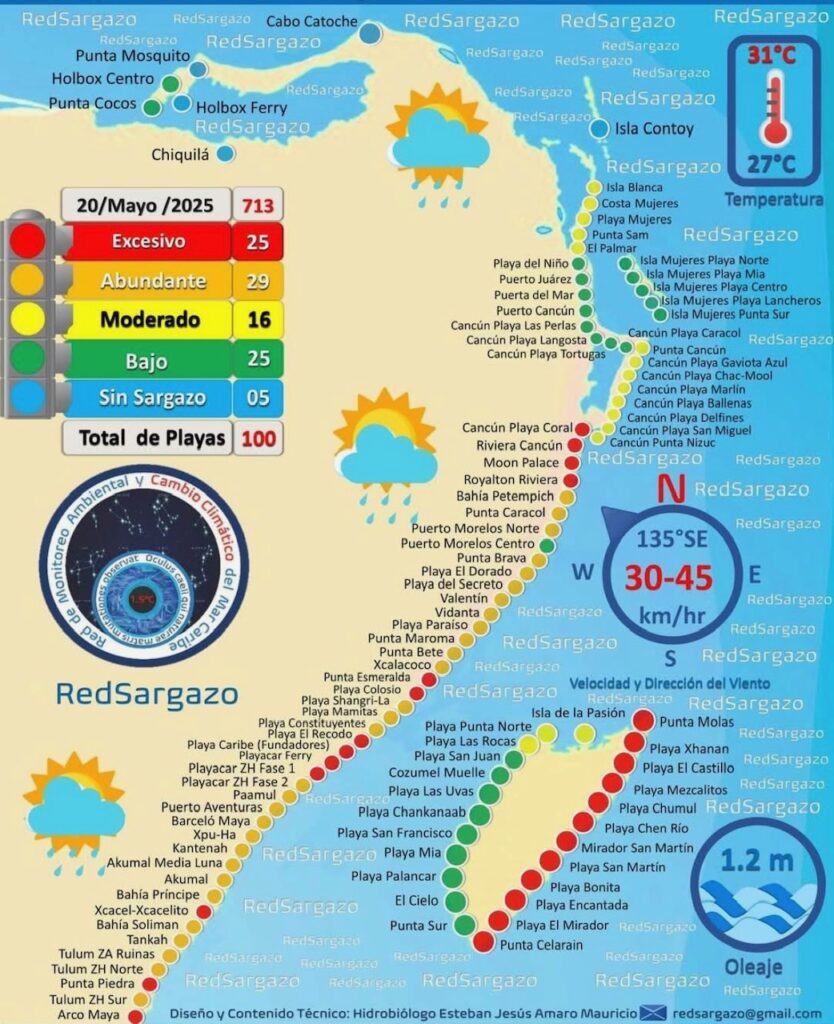
SargassumMonitering.com
This website covers the Carribean area, but it is zoomable for ju the Riviera Maya. They have a good map at SargassumMonitering.com that has photos & videos taken recently and some even the same day of the beaches and seaweed conditions. Note: This website is better viewed on a laptop and not mobile.
Common Questions about Seaweed
How will be the seaweed in (x) amount of time?
This is a question s we get all the time. How will the seaweed be next week or next month? The truth is it is fairly hard to predict. We can have one week where the beaches are beautiful and the next, we are swimming in the stuff. We know it is hard to plan a vacation with the unknowns if the beach will be nice or not, the best answer is to book vacations more from October to February when there tends to be much less opportunity for seaweed. If you have booked a vacation, be sure to incorporate some of the tips below so you have some good options to still have a great vacation and not worry so much about the seaweed.
Checking the website mentioned above that has local photos is another way to see what conditions are like in near real time.
Another unpredictable thing are the hurricanes that can happen in the summer season. We have observed that when there are hurricanes that passe between Cancun and Cuba, it often interrupts the flow of seaweed, and we can have a period of nice beaches.
Why has the sargassum become a problem?
There are different opinions to the cause. Not everything is known about it and studies are continuing. The most popular explanations are:
- Changing climate and wind patterns blowing the loose mats of seaweed to coastlines.
- Nutrient rich waters producing more sargassum (seaweed). Winds blowing dust from Africa into the Atlantic and runoff from Brazil are cited for this.
- Warmer waters breed the seaweed faster and the Caribbean has been warmer in the past few years.
Is there a sargassum seaweed season when it is worse?
In general, yes. Here in the Riviera Maya when the Caribbean starts to warm up, there tends to start more seaweed coming ashore This starts around April and goes to October. May/June sometimes are the peak but there are no guarantees. The lowest amounts of seaweed are usually November to February. This does help out tourist season a little since the peak tourism for the Riviera Maya is in winter months for the northern hemisphere.
Does seaweed only affect the Caribbean?
The beaches along the Texas coast have experienced sargassum inundation events annually, and since 2001 beaching events have also occurred on many Caribbean shores in nearly every spring and summer. Sargassum beaching events have also been reported in western Africa and northern Brazil.
Why is sargassum bad for the environment and economy?
Excessive amounts of Sargassum on beaches in populated areas can cause a lot of problems and they must be physically removed. Sargassum decomposition on beaches smells bad, attracts insects, and causes many environmental problems (e.g., smothering turtle nesting sites, sea turtle mortality, fish kills).
Quintana Roo State, where the Riviera Maya is gets 87% of the GDP from tourism. One of the main factors people look at when booking vacations to the area is the condition of the beaches. Tourists want to have clear beaches and be able to enjoy them without seaweed. When there are years with bad sargassum blooms, tourism is directly affected, and locals feel the economic crunch.
Are there any positives from seaweed?
In the ocean it serves as an important habitat for many marine animals as it provides food, shade, and shelter (from predators) to fish, shrimp, crabs, and turtles. Sargassum may serve as fertilizers for sand dunes and thus protects shoreline stability. It is also a marine resource for other uses such as biomass for food, fuel, and as a possible source of pharmaceutical materials.
In Playa Del Carmen when there is a lot of seaweed washing ashore, erosion slows, and the beaches can actually grow.
Removal of the Seaweed
So, what is being done about the removal oof the seaweed when it comes ashore? Local, state and federal governments are tackling this issue by a number of means.
Below are some of the measures taken to remove the seaweed:
- The city of Playa Del Carmen has crews that clean beaches when needed. This can be done by rake and wheel barrels or by tractors and trucks to take it away.
- Hotels (especially the all-inclusive hotels) send workers to clean the beaches in the mornings, so they look better for guests.
- Seaweed barriers. These have gone up along stretches of the Riviera Maya. There are different types of barriers. They do work with some efficiency, but with higher winds, often the seaweed is blow over the top of barriers and sometimes barriers become unanchored. It also creates a problem with what to do with the seaweed that collects behind them. There are also limited areas where barriers can be used. Some areas need boat and ferry access to the open ocean.
- Collection boats. A specially designed boat can collect up to 500 cubic meters of seaweed per day. In fact, the Mexican Navy has helped in the collection of seaweed. What are the issues with collecting it by boat? For one, it is expensive. There is a need for fleets of boats that require gas, manpower and a way to bring it ashore and truck it away.

Can you still enjoy a vacation to the Riviera Maya with seaweed?
Yes! There will be some limitations because the beaches might not be in the best shape, but we have tons of local information for you so that no matter what the seaweed forecast is, you can enjoy a vacation to the area.
Light amounts of seaweed
If there are light amounts of seaweed coming ashore, not all beaches are the same. See our map below to see what beaches naturally collect more and which beaches have less seaweed. We have three colors in the map. Areas that are a bay, often collect more and beaches that are parallel to the ocean often have less amounts of sargassum.
Caleta Tankha is also a good option when there are light amounts of seaweed. This beach area has natural protection and fresh water flowing into the ocean, keeping seaweed at bay.
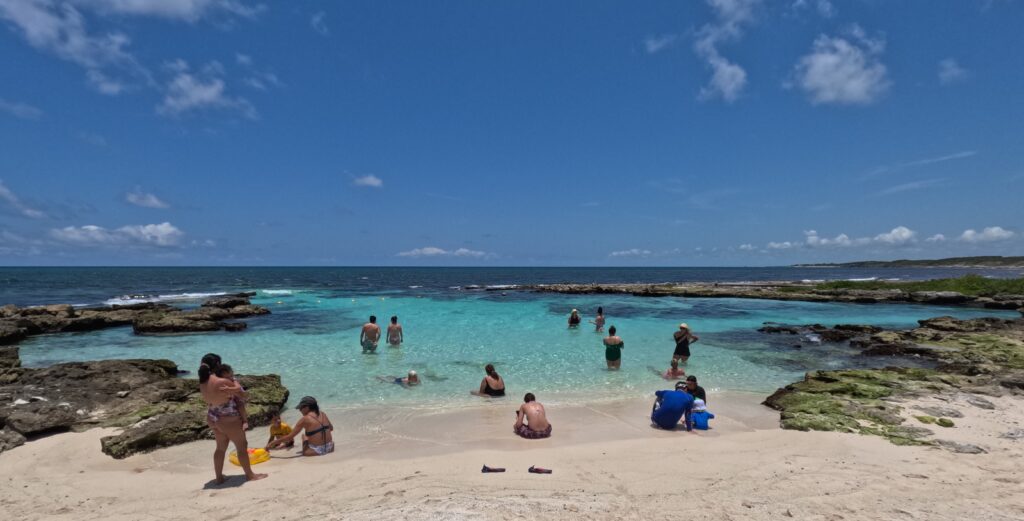
If there are heavier amounts of seaweed coming shore….
Here are some ideas and even places to stay that you can avoid many of the issues with seaweed.
All-inclusive hotel that is seaweed proof?
Many of our readers have thought about moving to another hotel just to find that perfect beach without seaweed. This is hard since it is so unpredictable. But we do have a great option for you. The new Hotel Xcaret Mexico has coves, rivers, sandy beaches and inlets that are beautiful and you will never miss the beach. See what this new all-inclusive hotel is like in the link. It just might save your vacation.
Tours and options to avoid the seaweed
Now that the seaweed has been here for a while, some people have just gotten used to it and swim out past where most of it is. However, there are some places you can go to avoid it.
- Visit a cenote in the Riviera Maya. These natural water pools are inland and have crystal clear water and since they are on land, these never have seaweed.
- Xel-Ha park is a natural inlet and has ground water flowing out to the ocean. This area is fairly clear of seaweed. Xcaret, Xplor and their other parks are also really fund days to spend without having to worry about seaweed.
- Visit a rooftop pool in Playa Del Carmen. Most of them charge a minimum consumption and great views. We have 7 of them mentioned in the article link.
- Take advantage of the visiting the interior of the Yucatan Peninsula. Everything is not all about the beach here and there are many treasures to explore. For example, there are Mayan ruins and colonial towns to visit. You can even take the Tren Maya to Chichen Itza or explore with the use of the train.
- One of the most consistent beaches that is not as affected is on Isla Mujeres called Playa Norte.
We know that most people come to the Rivera Maya for the turquoise waters, but there is so much more to see in the area and Yucatan Peninsula.


Be the first to comment